
php editor Apple has brought you a detailed guide on installing Debian and Debian 11. Debian is a popular Linux distribution, and Debian 11 is the latest version with many new features and improvements. In this article, we will detail how to install Debian and provide a step-by-step guide to help readers complete the installation process smoothly. Whether you are a beginner or an experienced user, this article will provide you with valuable reference and guidance. Whether you are installing Debian on a PC or a server, this article will provide you with detailed steps and precautions to help you complete the installation easily. Whether you want to try a new version of Debian or want to learn more about Debian, this article will be your best choice.

Install Debian:
1. Download the Debian image file
You need to download the image file suitable for your hardware architecture from the Debian official website , you can choose the ISO file that suits you and make sure to download the latest stable version.
2. Prepare USB drive
In order to boot the computer from a USB drive, you need to prepare a USB drive. Make sure your USB drive does not have important data because the process of making a bootable USB will format the drive. .
3. Make a bootable USB
Use the tool of your choice (such as Rufus, Etcher, etc.) to write the Debian ISO file to the USB drive and follow the tool's instructions to complete the creation process.
4. Start the computer and set the BIOS
Insert the prepared USB drive into the computer, restart the computer, enter the computer's BIOS settings, and change the startup sequence to boot from the USB drive first. Save settings and exit BIOS.
5. Install Debian
After booting the computer from the USB drive, you will see the Debian installation interface, follow the on-screen instructions, select the appropriate language, keyboard layout, etc., and then Select the installation method, you can choose automatic installation or manual configuration.
6. Configure the network and software source
During the installation process, you need to configure the network and software source. You can connect to the Internet and choose the software source that suits you. If you need other software Package or library, please add it when configuring the software source.
7. Installation Complete
After completing the installation process, you will need to set a root password, create a user account, and configure other system settings. Follow the on-screen instructions to complete these steps and then restart your computer. .
Install Debian 11:
If you want to install the latest Debian version, Debian 11, you can follow the steps below:
1. Download the Debian 11 image file
Visit the Debian official website and download the latest Debian 11 image file, select the ISO file suitable for your hardware architecture and download it.
2. Prepare a USB drive and make a boot USB
Same as installing Debian, you need to prepare a USB drive and make a boot USB, use tools such as Rufus, Etcher, etc. to write the Debian 11 ISO file USB drive.
3. Start the computer and set the BIOS
4. Install Debian 11
After booting the computer from the USB drive, you will see the Debian 11 installation interface, follow the on-screen instructions Follow the instructions, select the appropriate language, keyboard layout, etc., and then select the installation method, you can choose automatic installation or manual configuration.
5. Configure network and software source
6. Installation completed
Little knowledge sharing:
In Linux systems, we often use the terminal (Terminal ) to perform various commands and operations. The following are some commonly used Linux commands and techniques:
1. File operations: Use the ls command to list directory contents; use the cd command to switch directories; use the cp command to copy files or Directory; use the mv command to move or rename a file or directory; use the rm command to delete a file or directory; use the find command to find a file or directory; use the chmod command to change the permissions of a file or directory; use the chown command to change the owner of a file or directory; Use the tar command to pack and unpack files; etc.
2. System management: Use apt-get or apt command to manage software packages; use top or htop command to view system processes and resource usage; use df and du commands to view disk space and usage; use free command Check the memory usage; use the reboot or shutdown command to restart or shut down the computer; etc.
3. Network operations: Use the ping command to test the network connection; use the ifconfig or ip command to view and configure the network interface; use the ssh command for remote login and management; use the scp command for remote file transfer; use wget or curl Commands to download files; and so on.
4. Other commonly used commands: use the grep command to search for text; use the awk command to process text data; use the sed command to edit text streams; use the tar command to pack and unpack files; etc.
The above is the detailed content of Xiaosi LINUX shares: Detailed guide to installing Debian and Debian 11. For more information, please follow other related articles on the PHP Chinese website!




